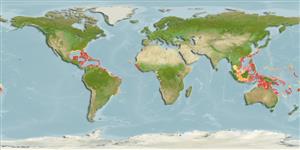Classification / Names
Common names from other countries
Main reference
Size / Weight / Age
Max length : 100.0 cm TL male/unsexed; (Ref. 4450); common length : 60.0 cm TL male/unsexed; (Ref. 5217); max. published weight: 1.3 kg (Ref. 40637)
Environment
Marine; reef-associated; depth range 1 - 60 m (Ref. 58047)
Climate / Range
Subtropical, preferred ?
Distribution
Western Atlantic: Bermuda, southern Florida (USA) and the Bahamas to northern South America, including the Gulf of Mexico and the Caribbean (Ref. 3255). Eastern Atlantic: Cape Verde and from Senegal to Gabon; including St. Paul's Rocks (Ref. 13121) and the islands of Bay of Biafra (Ref. 4450). Also southern Atlantic islands (Ref. 26938).
Countries | FAO areas | Ecosystems | Occurrences | Introductions
Short description
With arched jaws that touch only at their tips when mouth is closed (Ref. 26938).
IUCN Red List Status (Ref. 115185)
Threat to humans
Harmless
Human uses
Fisheries: subsistence fisheries
More information
ReferencesAquacultureAquaculture profileStrainsGeneticsAllele frequenciesHeritabilityDiseasesProcessingMass conversion
Tools
Special reports
Download XML
Internet sources
Estimates of some properties based on models
Phylogenetic diversity index
PD50 = 0.5002 many relatives (e.g. carps) 0.5 - 2.0 few relatives (e.g. lungfishes)
Trophic Level
4.5 ±0.8 se; Based on size and trophs of closest relatives
Resilience
Low, minimum population doubling time 4.5 - 14 years (Preliminary K or Fecundity.)
Vulnerability
High vulnerability (60 of 100)
Price category
